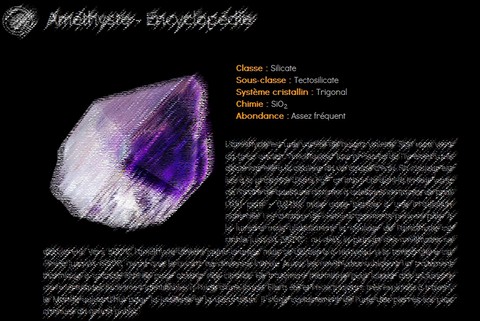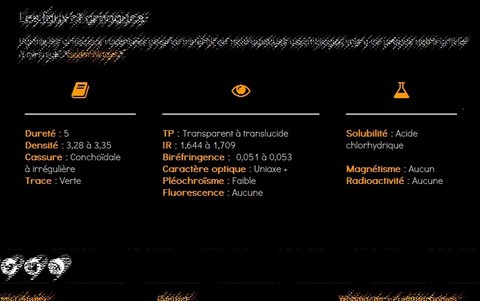 "Mineral" sheets user guide
"Mineral" sheets user guide
Introduction :

The 5 first lines are reminiscent of the general classification, mineral crystal system, its chemistry and its rarity. We will explain later how to have a little idea of the nature of the crystal system by using two simple instruments : refractometer and polariscope. Chemistry and structure of a mineral can of course be obtained through laboratory analysis : SEM or microprobe for chemistry and X-ray diffraction for the structure. We have talked about this subject in the following article : "How to identify a mineral ? - Part 2 - Laboratory technology"
Content of the sheet :
The sheets are divided into several sections and are based on the following structure :
- The first paragraph introduces and describes the species or mineral variety in a general way, are mainly discussed the etymology of the name, a brief history of its discovery, its morphology, its geological context(s) but also its usages.
- The second paragraph outlines the major deposits discovered to date in the World and have produced exceptional specimens, sometimes we reported crystal size records.
- The following section describes the most beautiful French deposits where the species was encountered.
- Another paragraph reveals the twinned crystals of the mineral species and its specific morphologies sometimes adopted.
- Finally, the last section focuses on the treatments and synthetics recorded around the mineral and how to detect them.
Specifications :

At the end of the sheet, properties of each mineral are reported. We will write soon how to use a refractometer and polariscope to determine in a practical way the refractive index (RI), birefringence and optical character. Solubility tells you here which acid or base used or not to clean or prepare minerals. Dissolution rates depend on the concentration of the chemicals and the nature of the mineral, they can be very slow and without effervescence (provide more than one month to dissolve the natrolite of a benitoite specimen matrix), regular monitoring is necessary to prevent the formation of precipitates. It is highly recommended to test the chemicals on a small sample before diving all the specimen in a solution.
Warning : The use of certain chemicals mentioned can be very dangerous and can cause serious irreversible injuries or death, they are also very environmentally toxic and should be treated in a suitable manner. The company "Le Comptoir Géologique" can't be held liable for accidents of all kinds related to the use of chemicals mentioned.
Property determination such as hardness, density, fracture, trace, pleochroism, fluorescence, magnetism and radioactivity are discussed in the following article : "How to identify a mineral ? - Part 1?"
